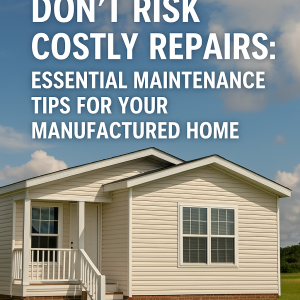Why Essential Maintenance Matters for Your Manufactured Home
Essential maintenance tips for your manufactured home are more than just a checklist—they are the difference between a comfortable, safe living space and unexpected, expensive repairs. Unlike traditional site-built homes, manufactured homes require specific care due to their unique construction and mobility features.
By investing time in routine upkeep, homeowners can extend the lifespan of critical systems, preserve the home’s resale value, and ensure compliance with safety standards. Regular inspections also reduce risks of mold, leaks, and structural damage, which can quickly escalate if ignored.
Roof Inspections: Stop Leaks Before They Start
Your manufactured home’s roof is its first line of defense against Florida sun, heavy rains, and high winds. A neglected roof is a recipe for water damage, mold, and weakened structures. Experts recommend inspecting your roof at least twice a year—spring and fall—for cracks, loose shingles, or signs of pooling water.
If your roof is made of rubber (EPDM) or metal, ensure seams and seals are intact. Applying a protective roof coating can extend its life and improve energy efficiency. The U.S. Department of Housing and Urban Development (HUD) provides guidelines for manufactured housing standards that include roof care and weatherproofing requirements.
Foundation and Skirting: Secure the Base
The stability of your manufactured home depends on its foundation and skirting. Over time, shifting soil, moisture, and pests can compromise these critical components. Inspect skirting panels for cracks, gaps, or signs of rodent intrusion. Damaged skirting not only impacts energy efficiency but also provides entry points for unwanted guests.
Check the foundation piers and tie-downs for rust or movement. Small shifts can create long-term structural problems. For official standards on manufactured home anchoring and stabilization, review the FEMA Guide to Manufactured Housing Installation.
Plumbing Systems: Avoid Hidden Water Damage
Plumbing issues are among the most common and costly problems in manufactured homes. Frequent causes include shifting foundations, extreme temperatures, and aging pipes. Inspect under-sink connections, water heaters, and exposed pipes for leaks or corrosion. Even small drips can add up to significant water damage if left unaddressed.
Insulating exposed pipes, especially in cooler climates, prevents freezing and bursting. It’s also wise to flush water heaters annually to remove sediment buildup. Refer to your home’s manufacturer manual for recommended plumbing maintenance schedules and upgrades.
HVAC Systems: Keep Comfort Costs Low
Heating, ventilation, and air conditioning (HVAC) systems in manufactured homes often work harder than in site-built homes due to smaller duct sizes and higher humidity levels. Dirty filters, clogged vents, or neglected ductwork can lead to higher utility bills and reduced air quality.
Change air filters every 1–3 months and schedule professional servicing annually. Clean ducts and vents regularly to prevent dust buildup. For further guidance, check the U.S. Department of Energy’s Heating and Cooling Resources.
Electrical Systems: Safety Above All
Electrical systems in manufactured homes should never be overlooked. Outdated wiring, overloaded circuits, or improperly installed appliances can increase the risk of fire. Look for signs such as flickering lights, warm outlets, or frequent breaker trips—these are red flags demanding immediate attention.
Consider upgrading your home’s electrical panel if it hasn’t been updated in over two decades. Always use licensed electricians familiar with manufactured housing standards, as improper repairs can void insurance policies.
Moisture and Ventilation: Prevent Mold Growth
Moisture buildup is a common issue in manufactured homes, especially in humid climates. Poor ventilation can lead to mold, mildew, and indoor air quality issues. Ensure that kitchen and bathroom exhaust fans vent to the outside, not just into the attic or crawlspace.
Installing vapor barriers under your home and using dehumidifiers in damp areas reduces excess moisture. For official mold prevention resources, visit the EPA’s Mold Guide.
Windows and Doors: Small Leaks, Big Bills
Drafty windows and doors may seem like a minor inconvenience, but they can significantly increase heating and cooling costs. Inspect seals, weatherstripping, and caulking around frames at least once a year. Replacing old weatherstripping is inexpensive and can save hundreds annually in energy bills.
Consider upgrading to double-pane, energy-efficient windows if your home still has older single-pane glass. The Department of Energy provides guidance on window and insulation improvements tailored for manufactured homes.
Exterior and Landscaping: The First Defense
The exterior of your manufactured home isn’t just about curb appeal—it’s a critical barrier against weather and pests. Regularly pressure wash siding, repaint every few years, and inspect for cracks that could allow moisture inside. Proper landscaping, including directing water runoff away from the home, prevents foundation issues.
Trim trees and shrubs away from siding and rooflines to minimize storm damage. Maintain a clear perimeter to reduce fire risk and discourage pests from nesting near your home.
